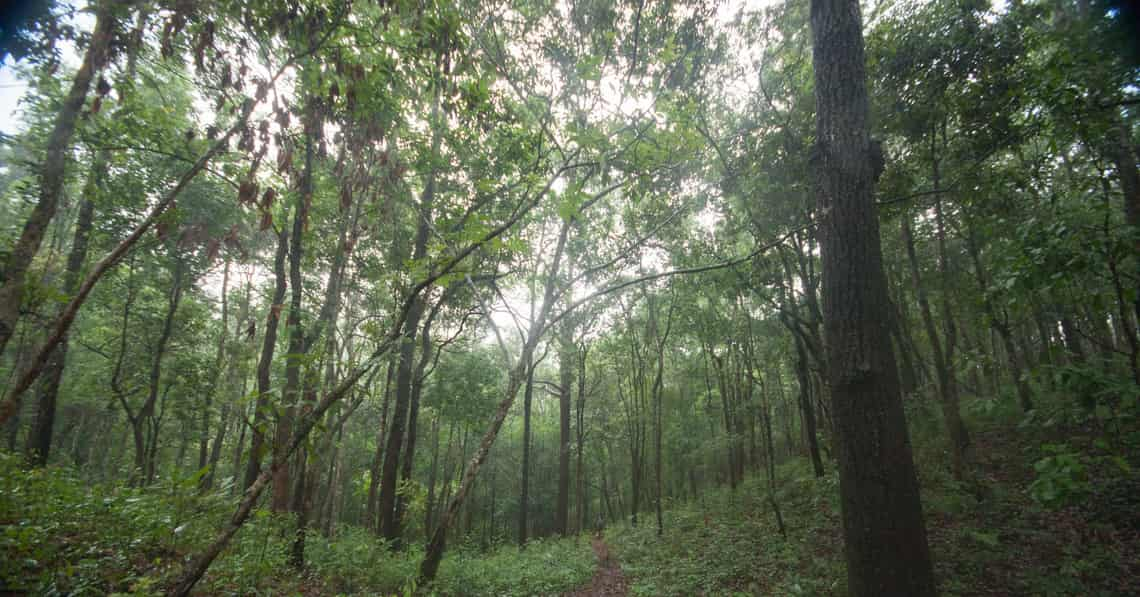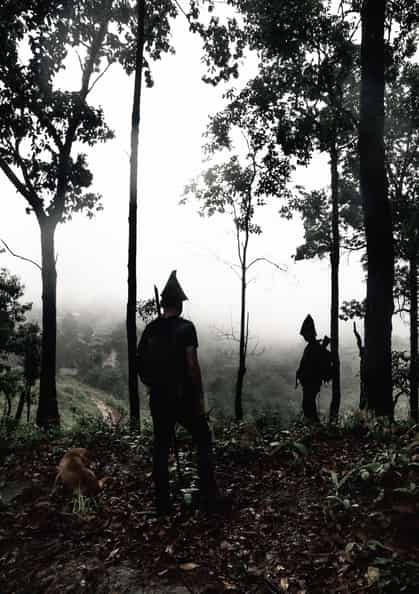
After slinging a .22 rifle over his shoulder, grabbing a few homemade squirrel traps and slipping on a pair of flip-flops, jungle-John was jungle-ready. Pi the photographer and I required a few more amenities, donning our steel-toed Gore-Tex hiking boots before managing to stuff our waterproof backpacks with bottles of water and a change of clothing. I even slipped a Swiss army knife into my pack…just in case.
Seemingly unfazed by the possibility of blood-sucking leeches, bugs, spiders and snakes, John strode forward into the green unknown with a slightly urgent pace, his eyes darting constantly from sky to floor in search of edibles and danger. Soon we found ourselves far from the beaten path, accompanied only by two curious village dogs. Walking along, John bent down to pick up a chunk from a rotting tree trunk, packing it away in his backpack. He explained that it was Kesiya pine, a naturally oily bark which would be perfect for starting a fire later that afternoon. As he rolled a cigarette from banana leaves and locally grown tobacco, I spent a moment taking in the rich sounds of the forest.
A bird song rang out over the canopy and innocently I asked, “What bird is that?” Before I could react, John had his .22 raised and aimed. He turned to me and said “I’ll show you,” just before a thunderous boom brought me out of my trance, as birds and animals scattered and a black bird dropped onto the jungle floor. I must admit that I was rather taken aback, but John casually explained that we now had dinner. Hunting was normal for John, and arguably more sustainable than farming. I gingerly picked up the warm body of a common Drongo bird, and continued deeper into the forest.
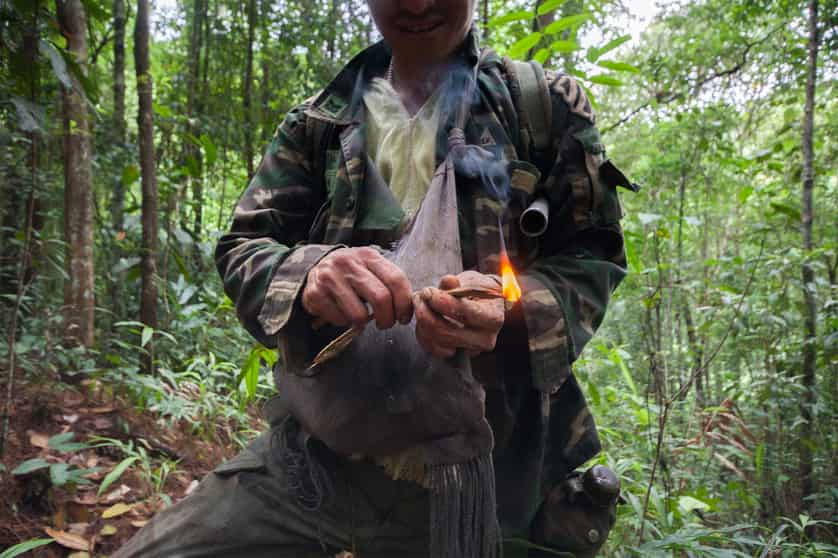
John grew up in the jungle and says that he had always known about plants and their properties, his father having taken him to hunt and gather from the age of ten. As we walked he would point things out to me, as I furiously jotted down names (phonetic), properties (possibly misunderstood), adding my version of a quick sketch (wildly inaccurate) in my notebook. I was channelling Darwin, feeling as though I was entering a new and exotic land, learning and documenting as I went.
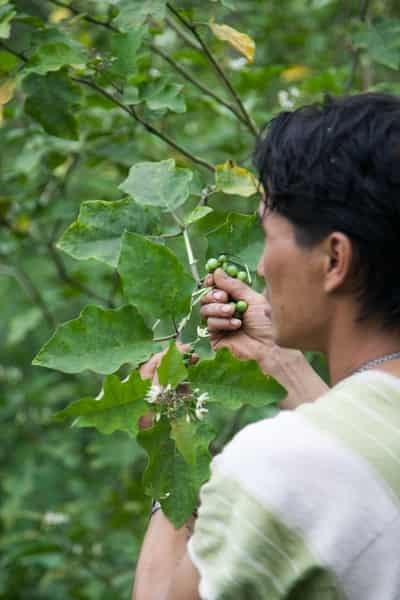
We continued into the jungle, faithful dogs trotting by our side, as John pointed out six foot galangal plants, thick grassy leaves that cure a sore throat when boiled, an incredibly bitter sprout that cures colds and a deep maroon coloured acutangular stemmed plant that, if eaten, sobers you up from drunkenness and other highs…apparently. Stopping at a large tree with dark brown bark, John began slicing off slithers of soft yellow under-bark which turned out to be the strongest and freshest cinnamon flavour I had ever tasted.
With a bag now brimming with plants and herbs, hunks of cinnamon bark, a few dead birds and a handful of mushrooms, we walked for another hour or so before we came to an opening deep in the forest where a small stilted hut sat in the middle of a paddy field. John explained that this was the last shelter to be found in this part of the mountains, and had we had time for a few more nights, we would have had to travel deeper and built our own. Using the pine collected at the start of our trek, John quickly had a fire going just in time to ward off the cold, as the rain began to bucket down.
Setting up camp, we grabbed two water bottles and headed to the nearest stream that John promised had “the cleanest water you will ever drink,” and I rather bravely, I thought, took a long cooling gulp.
As dusk’s mist began to roll in over the canopy, we used the last embers of light to harvest some wild mini green aubergines, dig up a handful of strange looking blue potatoes and a pluck some fresh leaves from the forest floor.
In a mortar made from bamboo, John mashed up salt, chillies and boiled mini green aubergines to make a chilli dip to eat with a soup made with the Dongo birds, potatoes and some of the leafy plants. As the rice boiled, we made plans to set up squirrel traps, but the rain was unrelenting and John said that this wasn’t squirrel-hunting weather. Our two faithful dogs had decided to join us for the duration and dissepared themselves for a while, presumably to hunt for food, before returning to snuggle into sleep underneath the hut. Following a surprisingly tasty meal, the moonshine came out accompanied by banana leaf cigarettes with freshly shaved cinnamon bark, and we sat, drank and smoke for a few hours before snuggling into the pile of blankets, thankfully left in the hut for passing travellers.
The rain did not let off the next morning and we decided there was no point waiting it out, as we fearlessly heading back into the lush rainforest. John crafted us a few hats made from wild banana leaves, as we foraged for our lunch. “I really wish you could have come for a few nights,” John sighed, explaining that then we would really have experienced his lifestyle of hunting and gathering. “But we have to make sure that we don’t go into the protected forest where hunting is forbidden,” he warned.
“We don’t earn any money really, I don’t work, and I just forage and hunt to support myself and the village. Most of us make no money, but we are totally self-sufficient.”
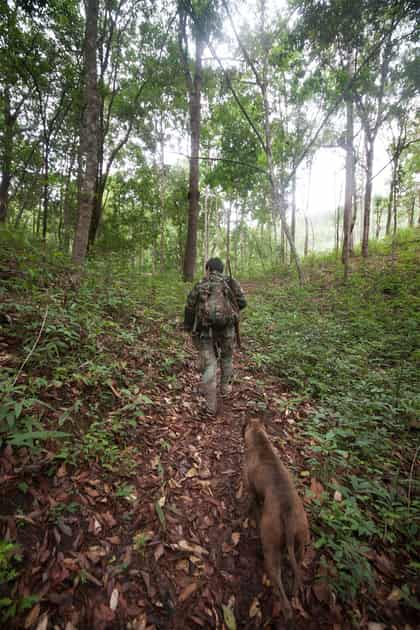
On our way back we bumped into John’s village friend, PriChai. He took us on a detour to meet his two elephants that he had let free to roam earlier that morning. Out of the hazy wet forest, the silhouette of a giant majestic bull elephant with long magnificent tusks followed by a smaller female came into view; seeing them in their natural habitat was humbling and awe inspiring.
As we neared the village, John suddenly brought up his rifle again, but after a good minute tracking something in the sky, put it back down. “That was a falcon but I couldn’t get a good aim. It could have fed us for a few days!”
As we walked into the village, I got a glimpse of what hunters and warriors of old must have felt returning home from a hunt; women came out of their huts to greet us and see what we had brought home and children ran alongside us, chattering and questioning. After a quick look, they walked away, obviously unimpressed with our measly haul.
John handed me a celebratory shot of moonshine as we talked about the problems facing the village as food source were becoming harder to find and more and more of the forest was becoming restricted to hunters. The conversation finished with the wives joking that it could be a good thing as the men often always slept out in the jungle and rarely spent much time at home.
As we waved good bye to John, the wives, the children and our two dogs, the village disappearing into the lush foliage, I couldn’t help but promise myself that I would be back again, perhaps after the rains. I feel privileged to have had such an opportunity and it made me realise how unsustainable and wasteful my modern life had become. After all, with the world all topsy-turvy these days, who knows when I might need such knowledge?
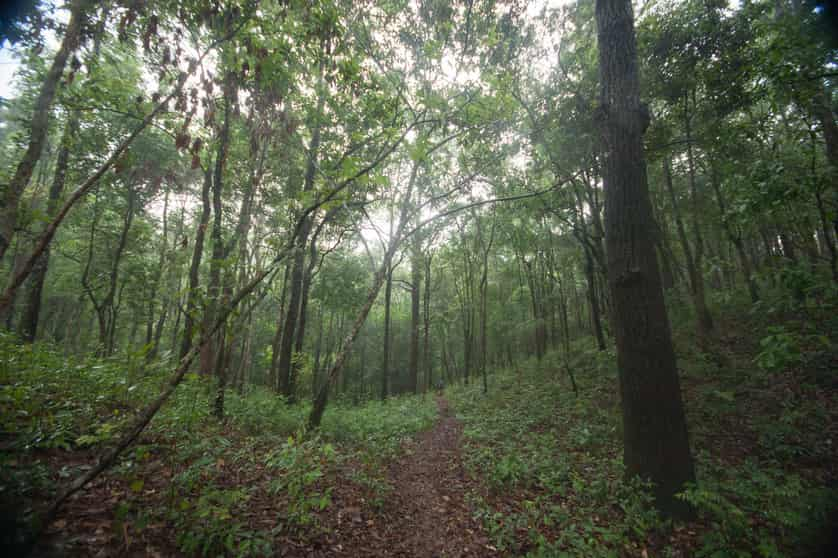
Thank you Nukul Chorlopo of Chai Lai Sisters who organised this trek for us. Their concept is to break away from standard tourist treks by providing real life adventures alongside indigenous Karen people organised by Karen women to open a window onto their lives while using the money earned to better their family and community life. The experience I had was unique and there is no ‘package tour’ for such a trek but individual expeditions can be arranged. They also have a solar powered eco-homestay run by Karen women for those looking for something less intense, with waterfalls, cooking classes and much more. For every guest they receive, the Chai Lai Sisters plant three trees, with over 1,000 trees planted to date.
Chai Lai Sisters also would like to make clear that they do no support hunting as a form of tourist entertainment, and stress that these experiences are designed to follow Karen people in their day to day lives as hunter gatherers. You can find out more about the sisters and the tours they provide by visiting www.chailaisisters.com or emailing explore@chailaiorchid.com and asking for Nukul.
